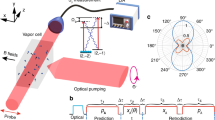Abstract
Some interpretations of quantum mechanics regard a mixed quantum state as a ensemble, each individual member of which has a definite but unknown state vector. Other interpretations ascribe a state vector only to anensemble of similarly prepared systems, but not to anindividual. Previous attempts to detect the hypothetical individual state vectors have failed, essentially because the state operator (density matrix) enters the relevant equations linearly. An example from nonlinear dynamics, in which a density matrix enters nonlinearly, is examined because it might appear to circumvent this difficulty. However, it is shown that the hypothetical individual state vectors can not be detected this way, so the adequacy of theensemble interpretation survives a critical test.
Similar content being viewed by others
References
K. R. Popper,Logik der Forschung (Vienna, 1934).
K. R. Popper, Quantum mechanics without ‘the observer,’ inQuantum Theory and Reality, M. Bunge, ed. (Springer, Berlin, 1967), pp. 7–44.
K. R. Popper, The propensity interpretation of the calculus of probability, and the quantum theory, inObservations and Interpretation, S. Koerner, ed. (Butterworths, London, 1957), pp. 65–70.
K. Gottfried,Quantum Mechanics (Benjamin, New York, 1966). “We always deal with states of an ensemble, whether the ensemble in question is pure or mixed.” (Sec. 20.1, p. 177.)
L. E. Ballentine,Quantum Mechanics (Prentice Hall, Englewood Cliffs, New Jersey, 1990).
A. Messiah,Quantum Mechanics (Wiley, New York, 1966). See Vol. I, Sec. 20.
L. I. Schiff,Quantum Mechanics (McGraw-Hill, New York, 1968), 3rd edn. See Sec. 42.
L. E. Ballentine, inFundamental Questions in Quantum Mechanics, L. M. Roth and A. Inomata, eds. (Gordon & Breach, New York, 1986), pp. 65–75.
L. E. Ballentine,Int. J. Theor. Phys. 27, 211 (1988).
L. E. Ballentine,Found. Phys. 20, 1329 (1990).
L. D. Landau and E. M. Lifshitz,Quantum Mechanics, Non-relativistic Theory (Pergamon, London, 1958), Sec. 12.
M. Morikawa,Phys. Rev. D 42, 2929 (1990), refers to the width of the probability distribution obtained from the diagonal elements of the density matrix,ρ(x, x), as “the typical system size.” In either of interpretations (A) or (B) that width relates to an ensemble distribution, and has nothing to do with the size of an individual.
Ref. 5, pp. 39–40.
H. Kaiser, S. A. Werner, and E. A. George,Phys. Rev. Lett 50, 560 (1983).
G. Cosma,Phys. Rev. Lett. 51, 1105 (1983).
L. E. Ballentine,Phys. Rev. A 44, 4126 (1991);44, 4133 (1991).
Author information
Authors and Affiliations
Rights and permissions
About this article
Cite this article
Ballentine, L.E. Can one detect the state of an individual system?. Found Phys 22, 333–342 (1992). https://doi.org/10.1007/BF01883899
Received:
Issue Date:
DOI: https://doi.org/10.1007/BF01883899



